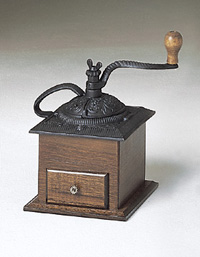

The fineness of the grounds has a major impact on the brewing process, and matching the consistency of the grind with the brewing method is critical to extracting the optimal amount of flavor from the roasted beans. Brewing methods which expose coffee grounds to heated water for a longer duration require a coarser grind than faster brewing methods. Beans which are too finely ground for the brewing method in which they are used will expose too much surface area to the heated water and produce a bitter, harsh, "over-extracted" taste. At the other extreme, an overly coarse grind will produce a weak, watery, under-flavored result.
The rate of deterioration increases when the coffee is ground, as a result of the greater surface area exposed to oxygen. With the rise of coffee as a gourmet beverage, it has become much more popular to grind the beans at home before brewing, and there are many home appliances available which are dedicated to the process.
In general, grind coffee as fine as you can without clogging the holes of the brewer or turning the coffee to mud. The finer the grind, the more contact there will be between coffee and hot water, and the faster and more thoroughly the essential oils will be released, without activating harsher, less-soluble chemicals.
On the other hand, you do not want to grind your coffee to a powder, because completely pulverizing it destroys the essential oil, which is partially vaporized by the heat and friction of the grinding process. Nor do you want to clog the holes in a coffee maker or filter, or fill your cup with sediment.
There are two types of grinders, Burr, and Blade.
Information Sources: Coffee Review and Wikipedia and Image Source: Stacy's Simple Stuff
Grinding
Burr Grinder | Blade Grinder | Types of Grinds
Java
Drip Brew | French Press | Percolator | Vac Pot | Chemex
Turkish | Pour-Over | Instant | Espresso | Grinding | Water Quality

















































